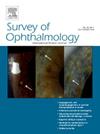Generative artificial intelligence in ophthalmology
IF 5.1
2区 医学
Q1 OPHTHALMOLOGY
引用次数: 0
Abstract
Generative artificial intelligence (AI) has revolutionized medicine over the past several years. A generative adversarial network (GAN) is a deep learning framework that has become a powerful technique in medicine, particularly in ophthalmology for image analysis. In this paper we review the current ophthalmic literature involving GANs, and highlight key contributions in the field. We briefly touch on ChatGPT, another application of generative AI, and its potential in ophthalmology. We also explore the potential uses for GANs in ocular imaging, with a specific emphasis on 3 primary domains: image enhancement, disease identification, and generating of synthetic data. PubMed, Ovid MEDLINE, Google Scholar were searched from inception to October 30, 2022, to identify applications of GAN in ophthalmology. A total of 40 papers were included in this review. We cover various applications of GANs in ophthalmic-related imaging including optical coherence tomography, orbital magnetic resonance imaging, fundus photography, and ultrasound; however, we also highlight several challenges that resulted in the generation of inaccurate and atypical results during certain iterations. Finally, we examine future directions and considerations for generative AI in ophthalmology.
眼科生成人工智能。
在过去几年里,生成式人工智能给医学带来了革命性的变化。生成式对抗网络(GAN)是一种深度学习框架,已成为医学领域的一项强大技术,尤其是在眼科和图像分析领域。在本文中,我们回顾了当前涉及生成式对抗网络的眼科文献,并重点介绍了该领域的主要贡献。我们简要介绍了生成式人工智能的另一种应用 ChatGPT 及其在眼科领域的潜力。我们还探讨了 GANs 在眼科成像中的潜在用途,特别强调了三个主要领域:图像增强、疾病识别和生成合成数据。我们对 PubMed、Ovid MEDLINE 和 Google Scholar 进行了检索,以确定 GAN 在眼科中的应用,检索时间从开始到 2022 年 10 月 30 日。本综述共收录了 40 篇论文。我们涵盖了 GANs 在眼科相关成像中的各种应用,包括光学相干断层扫描、眼眶磁共振成像、眼底摄影和超声波;不过,我们也强调了一些挑战,这些挑战导致在某些迭代过程中产生了不准确和不典型的结果。最后,我们探讨了生成式人工智能在眼科领域的未来发展方向和注意事项。
本文章由计算机程序翻译,如有差异,请以英文原文为准。
求助全文
约1分钟内获得全文
求助全文
来源期刊

Survey of ophthalmology
医学-眼科学
CiteScore
10.30
自引率
2.00%
发文量
138
审稿时长
14.8 weeks
期刊介绍:
Survey of Ophthalmology is a clinically oriented review journal designed to keep ophthalmologists up to date. Comprehensive major review articles, written by experts and stringently refereed, integrate the literature on subjects selected for their clinical importance. Survey also includes feature articles, section reviews, book reviews, and abstracts.
 求助内容:
求助内容: 应助结果提醒方式:
应助结果提醒方式:


